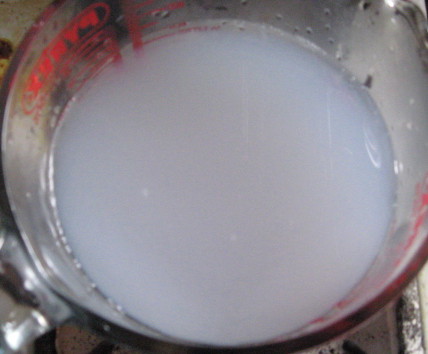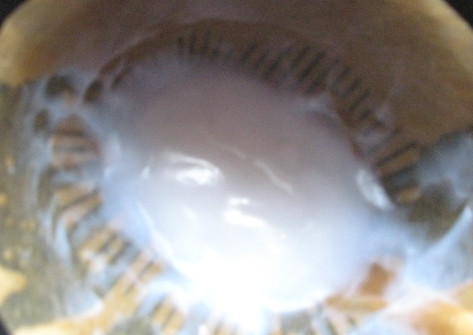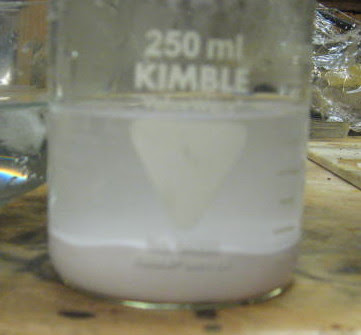ii) Double Magnesium Nitrates.—The crystallisation of the double magnesium nitrates of the rare earths was introduced by Drossbach227 for the
separation of neodymium and praseodymium. The cerium earths form double nitrates with magnesium nitrate of the general formula
2M1n(N03)3,3Mg(N03)2,24H20. The material used by him for this separation was a didymium lanthanum fraction obtained by the oxychloride method (II.
(/), p. 44). The mixture was converted into oxides which were then dissolved in nitric acid; the same quantity of nitric acid was treated with as much
magnesia as it would dissolve, and the two solutions were mixed. This ensures the addition of exactly the correct amount of magnesium nitrate for the
formation of the double salts. The mixed solution was then heated and small quantities of magnesia added until the solution was alkaline to congo
paper. 0n diluting the solution, impurities such as iron, manganese, aluminium, silica, and phosphoric acid were precipitated by the excess of
magnesia. The solution was then filtered and concentrated until practically the whole of the double nitrates had separated out, The crystals were
removed from the mother liquor, placed in a dish and treated with boiling water until only a small portion remained undissolved. Cooling was then
brought about byNfloating the dish in water at 30°-40°, and a small quantity of cold water was sprayed on to the surface of the solution. A quantity
of large crystals separated on the bottom of the dish, and as soon as about one-tenth of the total earths had crystallised out, the liquor was poured
from the crystals into a second dish which was floated on water at 10°-15° and cooled on the surface as before when a second crop of crystals was
obtained. The mother liquor from the second crop of crystals was then treated at o° in the same way, and a third crop of crystals obtained. The
mother liquor from the third crop of crystals was concentrated and the process repeated. The final mother liquor being rejected for this purpose was
used for the isolation of erbium, samarium, yttrium, and gadolinium which it contained. The various crops of crystals were then recrystallised
systematically when the following materials were obtained: neodymium containing traces of praseodymium, a little pure neodymium, and much lanthanum
containing praseodymium. The double magnesium nitrates of the rare earths crystallise from water in the order228, 229 lanthanum, praseodymium,
neodymium, excess magnesium nitrate, samarium, europium, erbium, gadolinium, and yttrium, and the remaining yttrium earths. By using this method,
Feit230 was able to concentrate terbium from a mixture of monazite earths in the least soluble fraction, and James 225 uses it for the initial
separation of the cerium earths.
|






























 <sub>3</sub> + B +
17H<sub>2</sub>
<sub>3</sub> + B +
17H<sub>2</sub>


 <sub>3</sub>(s)
--> Nd(OH)<sub>3</sub>(s) --> NdCl<sub>3</sub>(aq) --> NdF<sub>3</sub>(s)
<sub>3</sub>(s)
--> Nd(OH)<sub>3</sub>(s) --> NdCl<sub>3</sub>(aq) --> NdF<sub>3</sub>(s)

 <sub>3</sub> +
3NH<sub>4</sub>HF<sub>2</sub> == 2NdF<sub>3</sub> (s) + 3NH<sub>4</sub>HSO<sub>4</sub>
<sub>3</sub> +
3NH<sub>4</sub>HF<sub>2</sub> == 2NdF<sub>3</sub> (s) + 3NH<sub>4</sub>HSO<sub>4</sub>







 , so that once you’ve obtained it there’s a ‘what now?’ moment. You can fire it to Nd2O3 but that’s pretty
insoluble too. So, shortly I’ll be making some ‘magnet soup’ too and I think I’ll ‘go sulphate’, to be honest…
, so that once you’ve obtained it there’s a ‘what now?’ moment. You can fire it to Nd2O3 but that’s pretty
insoluble too. So, shortly I’ll be making some ‘magnet soup’ too and I think I’ll ‘go sulphate’, to be honest…












 Maybe I'll hit with some good 34% HCl when I get home, see what happens- If I can get
it clean enough as either a sulfate or chloride, I'm going to react it with some zinc acetate I have lying around. Thank God for my recent find of an
old photographer's chemical closet
Maybe I'll hit with some good 34% HCl when I get home, see what happens- If I can get
it clean enough as either a sulfate or chloride, I'm going to react it with some zinc acetate I have lying around. Thank God for my recent find of an
old photographer's chemical closet 





 Everything was looking great up until the end there - you did
everything I could think of to get the best product possible. I was excited about this route because of its simplicity and use of a cheap chemical.
Hopefully you have more luck with precipitation round 2.
Everything was looking great up until the end there - you did
everything I could think of to get the best product possible. I was excited about this route because of its simplicity and use of a cheap chemical.
Hopefully you have more luck with precipitation round 2.





 ) and thrown into a becker with all the Ni coating.
) and thrown into a becker with all the Ni coating.
 and ferric ions hydrolyse easily (much more easily than Nd3+), so yes, hydolysed species are likely to contaminate your (top photo) sample.
and ferric ions hydrolyse easily (much more easily than Nd3+), so yes, hydolysed species are likely to contaminate your (top photo) sample.

